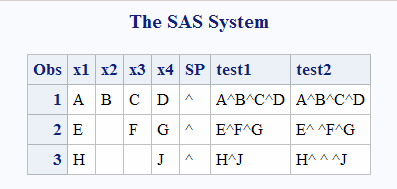CATX Function
Removes leading and trailing blanks, inserts delimiters, and returns a concatenated character string.
| Category: | Character |
| Restriction: | I18N Level 0 functions are designed for use with Single Byte Character Sets (SBCS) only. |
Syntax
Required Arguments
delimiter
specifies a character string that is used as a delimiter between concatenated items.
item
specifies a constant, variable, or expression, either character or numeric. If item is numeric, then its value is converted to a character string by using the BESTw. format. In this case, SAS does not write a note to the log. For more information, see The Basics.
Details
The Basics
The CATX function first
copies item-1 to the result,
omitting leading and trailing blanks. Then for each subsequent argument item-i, i=2, …, n, if item-i contains at least one non-blank character,
then CATX appends delimiter and item-i to the result,
omitting leading and trailing blanks from item-i. CATX does not insert the delimiter at the beginning or end of the
result. Blank items do not produce delimiters at the beginning or
end of the result, nor do blank items produce multiple consecutive
delimiters.
Length of Returned Variable
In a DATA step, if the
CATX function returns a value to a variable that has not previously
been assigned a length, then that variable is given a length of 200
bytes. If the concatenation operator (||) returns a value to a variable
that has not previously been assigned a length, then that variable
is given a length that is the sum of the lengths of the values which
are being concatenated.
Length of Returned Variable: Special Cases
The CATX function returns
a value to a variable, or returns a value in a temporary buffer. The
value that is returned from the CATX function has the following length:
If CATX returns a value
in a temporary buffer, the length of the buffer depends on the calling
environment, and the value in the buffer can be truncated after CATX
finishes processing. In this case, SAS does not write a message about
the truncation to the log.
Comparisons
The results of the CAT,
CATS, CATT, and CATX functions are usually equivalent to results that are produced by certain combinations
of the concatenation operator (||) and the TRIM and LEFT functions.
However, the default length for the CAT, CATS, CATT, and CATX functions
is different from the length that is obtained when you use the concatenation
operator. For more information, see Length of Returned Variable.
Using the CAT, CATS,
CATT, and CATX functions is faster than using TRIM and LEFT, and you
can use them with the OF syntax for variable lists in calling environments
that support variable lists.
Note: In the case of variables
that have missing values, the concatenation produces different results.
SeeConcatenating Strings That Have Missing Values.
Examples
Example 1: Concatenating Strings That Have No Missing Values
Example 2: Concatenating Strings That Have Missing Values
Copyright © SAS Institute Inc. All rights reserved.
